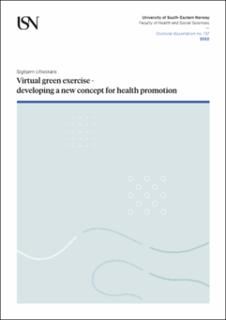Virtual green exercise - developing a new concept for health promotion
Doctoral thesis
Published version
Permanent lenke
https://hdl.handle.net/11250/3018427Utgivelsesdato
2022Metadata
Vis full innførselSamlinger
Sammendrag
Introduction
Recent advances in virtual reality (VR) technology have been followed by extensive interest within research and health promotion, including the field of green exercise. Green exercise refers to any physical activity in natural environments. This type of exercise has been associated with additional psychophysiological health benefits compared to indoor and urban exercise, such as stress reduction and improved mental well-being. Virtual green exercise seeks to apply VR technology to extend the benefits of green exercise to people who are unable to engage in active visits to real nature and to improve methodological rigor in studies investigating the potential benefits of green exercise by allowing lab-based experiments that simulate outdoor environments. Unfortunately, VR technology may also cause negative side effects in the form of cybersickness, leading to negative reactions such as dizziness, nausea and general discomfort. This thesis aims to understand how the potential health benefits of virtual green exercise can be maximized while simultaneously minimizing undesirable side effects such as cybersickness. The thesis summarizes five studies that applied VR technology to develop and optimize a protocol for virtual green exercise.
Methods
Four experimental studies with different study designs (Studies 1, 2, 3 and 5) and one narrative review (Study 4) were conducted with a primary focus on assessing the acute effects of virtual green exercise. Either quantitative- or mixed-methods were implemented in the respective studies. This research was designed as a continuous process, which means that each study guided the design and procedures of the following study. In total, 136 people volunteered and participated in the experimental studies. The gender distribution was balanced with 68 males and 68 females. The majority of participants were young, healthy, and active individuals.
Results
Study 1 compared virtual green exercise, in the form of 360˚ videos, to both real green exercise and a sedentary exposure to virtual nature. The results showed that the concept had potential, but also that cybersickness had a profound impact on experiences in virtual green exercise. This malaise was negatively associated with indicators of psychophysiological health, leading to negative affective responses and low levels of enjoyment. Study 2 compared 6 two 360˚ videos with different levels of scene stability to assess whether improved stability could reduce the severity of cybersickness. The results revealed that improved stability in 360˚ videos significantly reduced issues related to cybersickness and negative affective outcomes. Study 3 expanded on these results and found that postural instability is both a potential cause and objective measure of cybersickness, but also that the relation between postural instability and cybersickness is highly individual. Study 4 comprised a review of literature that was conducted (1) to identify common issues with modern VR technology, (2) to identify the most likely areas of application for virtual green exercise, and (3) to describe best practice for virtual green exercise research. Study 5 implemented the techniques and procedures identified in Study 4, comparing two different techniques for creating virtual natural environments (i.e. 360˚ video and 3D model) and a control condition comprising indoor exercise. The results showed minimal impact of cybersickness in the two virtual conditions. The level of enjoyment, a key factor for exercise participation, was higher after virtual green exercise compared to indoor exercise. All three experimental conditions in Study 5 improved affect and reduced indicators of stress, with no significant differences between conditions.
Conclusion
These results demonstrate that adopting virtual green exercise within health promotion and research requires the use of appropriate techniques to create and deliver enjoyable experiences without causing cybersickness. Scene stability emerged as a major factor contributing to cybersickness and negative affective responses. When scene stability was improved and appropriate techniques were implemented, the results support the use of virtual green exercise within physical activity promotion in particular, as the levels of enjoyment were higher after virtual green exercise compared to indoor exercise in Study 5. The results also highlight the challenges of reproducing the range of psychophysiological health benefits associated with real green exercise.

